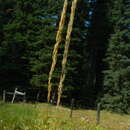Comprehensive Description
provided by North American Flora
Trisetum wolfii Vasey, Monthiy Rep. U. S. Dep. Agr Feb. Mar. 156. 1874.
Trisetum subspicatum var. muticum Bolander; S. Wats. Bot. Calif. 2: 296. 1880. (Type from
Upper Tuolumne, California, Bolander 5010.) Trisetum Brandegei Scribn. Bull. Torrey Club 10: 64. 1883. (Type from Cascade Mountains.
Brandegee &■ Tweedy in 1882.) Graphephorum Wolfii Vasey; Coult. Man. 423. 1885. (Based on Trisetum Wolfii Vasey.) Trisetum muticum Scribn. Bull. U. S. Dep. Agr. Agrost. 11: 50. 1898. (Based on Trisetum subspicatum var. muticuyn Boland.) Graphephorum muticum A. Heller, Cat. N. Am. PI. ed. 2. 31. 1900. (Presumably based on Trisetum
subspicatum var. muticum Boland.) Trisetum Wolfii muticum Scribn. Rhodora 8: 88. 1906. (Based on Trisetum subspicatum var.
muticum "Thurljcr.") Graphephorum Brandegei Rydb. Fl. Rocky Mts. 61. 1917. (Based on Trisetum Brandegei Scribn.) Trisetum Wolfii var. Brandegei Louis-Marie, Rliixlora 30: 241. 1928. (Based on Trisetum Brandegei
Scribn.) Trisetum Wolfii var. Brandegei forma muticum Uniis-Marie, Rhtxlora 30: 241. 1928. (Based on
T. muticum Scribn.) Perennial; culms erect, loosely tufted, sometimes with short rhizomes, glabrous, 50-100 cm. tall; sheaths scabrous, or rarely the lower pilose, 2 or 3 above the base; ligule trimcate, ciUate, 1-2 mm. long; blades flat, mostly erect, scabrous, rarely pilose on the upper surface, usually rather short, 2-4 mm. wide; panicle erect, rather dense but scarcely spikelike, green or pale, sometimes purplish, S-I5 cm. long, the axis scabrous on the angles, the branches and pedicels scaberulous; spikelets 5-7 mm. long, 2-flowered, sometimes 3-flowered, the rachillajoint about 2 mm. long, rather sparingly villous; glumes nearly equal, acuminate, about 5 mm. long; lemmas obtusish, scaberulous, 4—5 mm. long, awnless or with a minute awn below the tip, the callus-hairs scant, about 0.5 nun. long.
Type locality: Twin Lakes, Colorado (Wolf).
Distribution: Meadows and moist ground, at medium altitudes in the mountains, Montana to Washington, and southward to New Mexico and California.
- bibliographic citation
- Albert Spear Hitchcock, Jason Richard Swallen, Agnes Chase. 1939. (POALES); POACEAE (pars). North American flora. vol 17(8). New York Botanical Garden, New York, NY
Physical Description
provided by USDA PLANTS text
Perennials, Terrestrial, not aquatic, Rhizomes present, Rhizome short and compact, stems close, Stems nodes swollen or brittle, Stems erect or ascending, Stems solitary, Stems caespitose, tufted, or clustered, Stems terete, round in cross section, or polygonal, Stem internodes hollow, Stems with inflorescence less than 1 m tall, Stems, culms, or scapes exceeding basal leaves, Leaves mostly basal, below middle of stem, Leaves mostly cauline, Leaves conspicuously 2-ranked, distichous, Leaves sheathing at base, Leaf sheath mostly open, or loose, Leaf sheath smooth, glabrous, Leaf sheath hairy, hispid or prickly, Leaf sheath and blade differentiated, Leaf blades linear, Leaf blades 2-10 mm wide, Leaf blades mostly flat, Leaf blades mostly glabrous, Leaf blades more or less hairy, Leaf blades scabrous, roughened, or wrinkled, Ligule present, Ligule an unfringed eciliate membrane, Inflorescence terminal, Inflorescence an open panicle, openly paniculate, branches spreading, Inflorescence solitary, with 1 spike, fascicle, glomerule, head, or cluster per stem or culm, Inflorescence branches more than 10 to numerous, Lower panicle branches whorled, Flowers bisexual, Spikelets pedicellate, Spikelets sessile or subsessile, Spikelets laterally compressed, Spikelet less than 3 mm wide, Spikelets with 2 florets, Spikelets with 3-7 florets, Spikelets solitary at rachis nodes, Spikelets all alike and fertille, Spikelets bisexual, Spikelets disarticulating above the glumes, glumes persistent, Spikelets disarticulating beneath or between the florets, Rachilla or pedicel hairy, Glumes present, empty bracts, Glumes 2 clearly present, Glumes equal or subequal, Glumes equal to or longer than adjacent lemma, Glumes keeled or winged, Glumes 1 nerved, Glumes 3 nerved, Lemma similar in texture to glumes, Lemma 5-7 nerved, Lemma glabrous, Lemma apex truncate, rounded, or obtuse, Lemma apex dentate, 2-fid, Lemma awnless, Lemma mucronate, very shortly beaked or awned, less than 1-2 mm, Lemma margins thin, lying flat, Lemma straight, Callus or base of lemma evidently hairy, Callus hairs shorter than lemma, Palea present, well developed, Palea membranous, hyaline, Palea longer than lemma, Palea 2 ner ved or 2 keeled, Stamens 3, Styles 2-fid, deeply 2-branched, Stigmas 2, Fruit - caryopsis.
Trisetum wolfii: Brief Summary
provided by wikipedia EN

Trisetum wolfii stems and leaves
Trisetum wolfii is a species of grass known by the common names Wolf's trisetum and Wolf's false oat. It is native to western North America, including southwestern Canada and the western United States. It occurs in mountain habitat at moderate to high elevations below the tree line, such as spruce, fir, and aspen stands. It is a perennial grass forming clumps of erect stems growing up to about 80 centimeters in maximum height, occasionally reaching one meter. The narrow leaves are mostly located on the lower third of the clumped stems. The inflorescence is a narrow, erect panicle with spikelets green, brownish, or purple in color.
- license
- cc-by-sa-3.0
- copyright
- Wikipedia authors and editors


 Trisetum wolfii stems and leaves
Trisetum wolfii stems and leaves